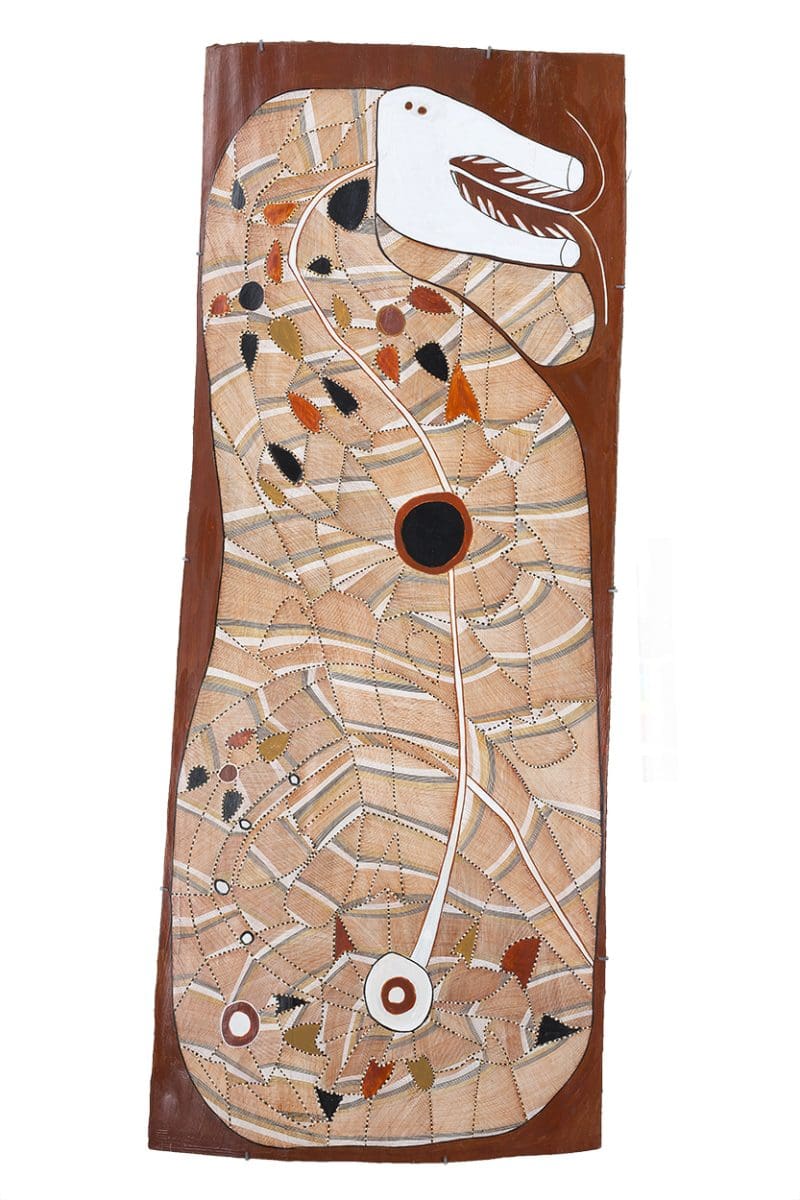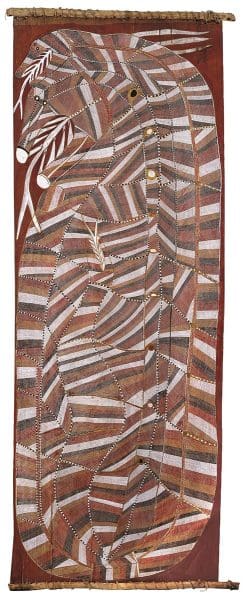
Finding New Spaces Together
‘Vádye Eshgh (The Valley of Love)’ is a collaboration between Second Generation Collective and Abdul-Rahman Abdullah weaving through themes of beauty, diversity and the rebuilding of identity.




The touring exhibition John Mawurndjul: I am the old and the new is about to reach its second last stop: Bunjil Place in Melbourne. Anna Dunnill spoke to one of the exhibition’s co-curators, Clothilde Bullen, at the beginning of its two-year-long journey.
For over three and a half decades, from Arnhem Land to Paris, John Mawurndjul has refined and pushed the parameters of his practice. He is a masterful painter, whose works on bark and wood are experimental, intricate, and exceptionally beautiful.
They are also emphatically contemporary, as a major survey exhibition of Mawurndjul’s work – John Mawurndjul: I am the old and the new – demonstrates.
Produced in collaboration by the Art Gallery of South Australia and the Museum of Contemporary Art, I am the old and the new features over 150 works spanning Mawurndjul’s 35-year career, selected by the artist and showing the trajectory of his practice. A Kuninjku artist from western Arnhem Land, Mawurndjul’s practice is steeped in his knowledge of Country and ceremony. Taught to paint the stories of Country by his brother and uncle, he was among the first group of artists in western Arnhem Land to paint on bark, and has remained a leader and innovator in the field.
She explains while there certainly is an ancient and sustained art practice in Kuninjku culture, this has traditionally taken the form of body painting and weaving, as well as cave painting – the area holds a number of significant and sacred rock art sites. The fine cross-hatching marks (rarrk) seen in Mawurndjul’s work have their roots in these continuous practices.
Earlier in his career, the artist’s bark paintings primarily reflected the figurative traditions familiar to local artists, portraying the Ngalyod (an ancestral rainbow snake), Namarrkon (the female lightning spirit), as well as fish, turtles, crocodiles, and other resources from the area. Executed with fine lines and a sharp eye for composition, the ochre figures push right to the edge of the bark, rich with patterned detail.
While I am the old and the new includes many of these striking works, the exhibition focuses on the later developments in Mawurndjul’s practice. In particular, he is renowned for his abstracted depictions of the Mardayin ceremonies, which underpin Kuninjku law and culture.
These shimmering, intricate paintings see sheets of bark entirely covered by incredibly fine parallel lines, produced using a manyilk (sedge brush). Optically astounding, they convey expressions of radiating power, often anchored by a central circle representing a waterhole. In Kuninjku lore, this is the home of the Ngalyod, as well as the Yawkyawk, a mermaid-like creature who is said to be eaten by the Ngalyod on the banks of the waterhole in a perpetual cycle.
The rocky outcrops around waterholes are also home to the mimih spirits, benign creatures which Mawurndjul depicts in wood. Tall and thin, able to slip between rocky crevices, the mimih are longtime observers of human behaviour and like to mimic them; they rarely venture out, however, as they are prone to being blown away by gusts of wind. He also produces lorrkon poles, traditionally used as bone co ins, bringing his mastery of the rarrk to these forms.
Mawurndjul’s paintings are anchored by significant sites in his custodial Country, and their associated moieties: Duwa (black cockatoo) and Yirridjdja (white cockatoo). Everything in the universe is assigned to one of these moieties, which define kinship and hold a balance within community and the environment. In I am the old and the new, works are arranged according to moiety and then according to site.
“As John has gained in knowledge and wisdom – particularly as it relates to different ceremonies and different sites – and as he’s been taught by his father and uncle, so too his work has progressed and changed, because he’s reflecting that in an abstracted way. As you gain wisdom you can become a better artist, essentially – especially in Kuninjku culture.”
While Mawurndjul has been included in international exhibitions since the 1980s, Bullen says that at first the interest in Aboriginal art framed it as “more ethnographic.”
“John kind of rode that perception out,” she says, “as did many Aboriginal artists at the time. His work has never been particularly of that ilk – it really is contemporary art.”
Reinforcing the work’s contemporaneity and centering the artist’s own narrative, I am the old and the new is entirely bilingual, with all materials produced in both Kuninjku and English. An app featuring Mawurndjul’s discussion of works will help viewers to immerse themselves in Kuninjku Country: its ochres, trees, rock, waterholes, and language. From concept
to materials, the elements of Country are vital to understanding.
Aesthetically and intellectually complex, this is the work of one of Australia’s most important living painters.
John Mawurndjul: I am the old and the new
Bunjil Place
24 November – 17 January 2021
Charles Darwin University Art Collection & Art Gallery
11 March – 29 May 2021
This article was originally published in the July/August 2018 print edition of Art Guide Australia.